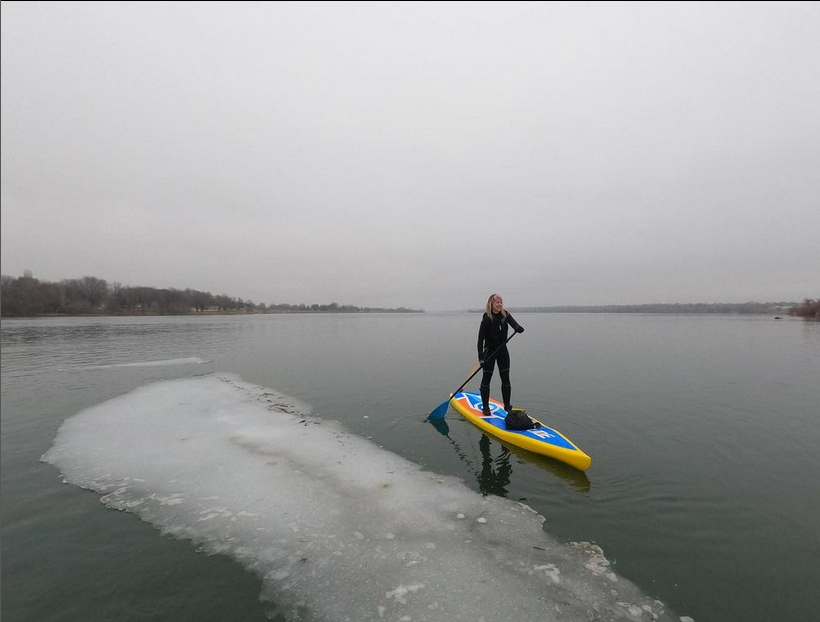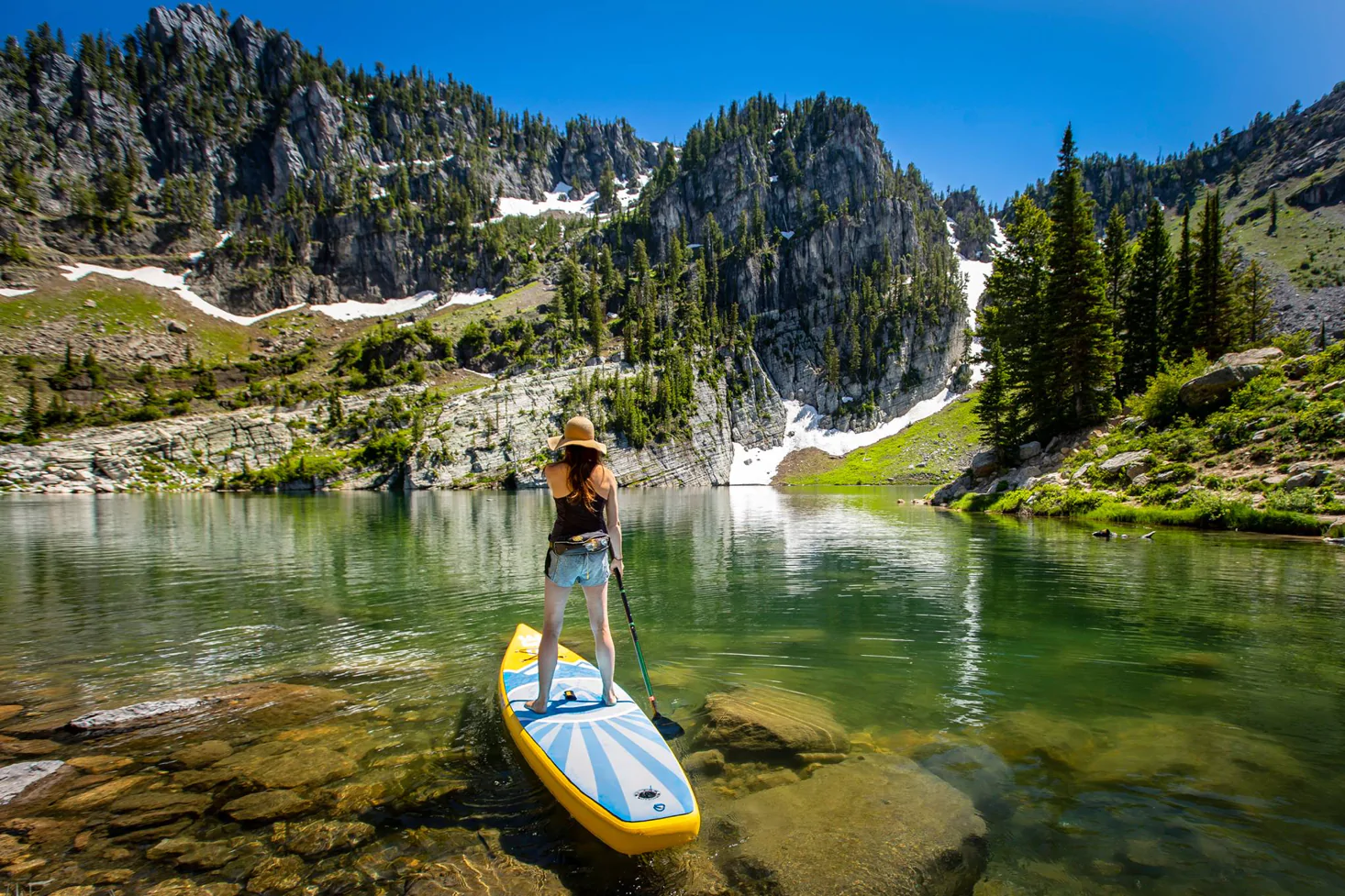
Hiking Paddle Board and SUP Camping: Explore the Backcountry Beyond the Water’s Edge
Ready to take paddle boarding off the beaten path? Learn how to hike with your SUP, pack efficiently, and explore remote lakes with Glide’s adventure boards.
A hiking paddle board unlocks remote wilderness adventures by blending backpacking freedom with SUP performance.
Glide’s lightweight, durable inflatables—especially the O2 Quest and O2 Retro—offer stability, gear space, and unmatched portability for SUP campers seeking off-grid exploration.
Table of contents
The Rise of SUP Hiking Adventures
Paddleboard camping opens up a new way to experience the outdoors—but what if the best water is miles from the road? That’s where SUP hiking comes in. By combining backpacking and paddle boarding, you can trek deep into the wilderness and explore pristine alpine lakes, hidden rivers, and remote campsites few ever reach.
With modern inflatable paddle boards like Glide’s O2 Quest and O2 Retro, SUP hiking is no longer a back-breaking ordeal. These boards are ultralight, rugged, and pack down small enough to hike comfortably, turning any backcountry trail into the start of your next water adventure.

Why Glide Boards Excel for SUP Hiking
1. Lightweight Design That Goes the Distance
Carrying a full-size paddle board used to mean sore shoulders and limited range. Glide solved this with their AeroMatrix™ woven drop stitch core—a cross-woven structure that delivers incredible rigidity at a fraction of the weight.
The result? A 12′6″ touring board that feels like a hard board on the water but carries like a sleeping bag on the trail. Whether you’re hiking one mile or five, the difference is immediate: less fatigue, faster setup, and more time to explore.
2. Built Tough for Backcountry Conditions
Every Glide board is constructed with ThermoFuse™ triple-layer rails and quadruple-layer military-grade PVC, making them virtually indestructible. Scrape them across rocky shorelines or set up camp beside driftwood—they can handle it all.
The O2 Quest, with its higher PSI rating and thick rail design, remains stiff under load even when packed with 50 pounds of camping gear. It’s as confident on a glassy mountain lake as it is in a mild current.
3. Performance That Feels Effortless
When you’re miles from civilization, you want a board that glides efficiently. The O2 Quest features a touring profile—12′6″ long, 30″ wide—with a US-style removable fin for customizable tracking. Its shape cuts through water with minimal drag, helping you paddle faster and conserve energy.
For those who prefer versatility, the O2 Retro (10′6″ x 33″) offers all-around stability—perfect for shorter hikes or when you’re sharing the board with a dog or child. Both models provide a full-length EVA deck pad for comfort during long paddles or when kneeling to adjust gear.
Packing Smart for a Hiking Paddle Board Adventure
The Backpack Makes the Difference
Every Glide inflatable comes with a backpack-style carry bag with wheels, engineered for serious hikers. Wide shoulder straps, padded lumbar support, and an ergonomic frame keep weight evenly distributed. Unlike generic SUP packs, Glide’s is designed for multi-mile treks, not just parking-lot strolls.
What to Pack Inside
For a successful SUP hiking trip, balance essentials with portability:
-
Dry bags for tent, sleeping bag, and clothes.
-
Compact camp stove and titanium cookware.
-
Lightweight paddle, preferably a 3-piece carbon model.
-
Repair kit and pump (manual or battery).
-
Food, water, and purification system.
-
First aid kit and headlamp.
-
Personal flotation device (PFD) and leash.
Keep heavier gear low and close to your back for stability. Once at your destination, dry bags strap easily under the front and rear bungees of the Quest or Retro for balanced load distribution.

Comparing Glide Boards for Hiking & Camping
Model
Length x Width
Capacity
Ideal Use
| O2 Quest | 12′6″ × 30″ | 400 lbs | Long-distance hikes & touring lakes |
| O2 Retro | 10′6″ × 33″ | 400 lbs | All-around paddling & shorter hikes |
Both boards include the AirThrone kayak seat option, converting them to sit-down kayaks for relaxing evenings on the water after a long hike.
Setting Up Camp on Remote Shores
Arriving at a secluded alpine lake with your paddle board is one of the most rewarding experiences in outdoor adventure. Once you’ve inflated your SUP (the electric pump and battery pack make quick work of it), you’ll have:
-
Room to carry a dry bag, cooler, and small tent.
-
The ability to paddle to multiple shoreline campsites for the perfect view.
-
An ideal platform for fishing or morning coffee on the water.
When breaking camp, deflate your board halfway before packing—it reduces bulk but protects the seams. The woven drop-stitch core allows you to roll it tightly without damaging the structure.
Safety and Comfort on the Trail
Even with lightweight boards, safety is key:
-
Check forecasts for sudden mountain weather changes.
-
Wear your PFD, especially on cold alpine lakes.
-
Store your pump, repair kit, and emergency whistle accessibly.
-
Hydrate often—hiking at elevation can deplete energy faster.
Thanks to Glide’s comfortable backpack system, you’ll find that hiking a few miles with your paddle board is surprisingly manageable—and even enjoyable.

Final Thoughts on Hiking with a Paddle Board
Hiking with a paddle board expands what’s possible for outdoor explorers. Whether you’re trekking into a quiet mountain lake or setting up camp beside a hidden river, Glide’s O2 Quest and O2 Retro make it effortless to carry adventure wherever you go.
With cross-woven drop stitch technology for stiffness, fused rails for durability, and backpacks built for distance, these boards are purpose-built for the backcountry paddler who wants freedom beyond the shoreline.
Pack light, hike far, and paddle where few have ever been. That’s the true spirit of SUP hiking.
FAQs
How far can you hike with a paddle board?
With Glide’s backpack design and lightweight construction, hiking 1–3 miles is realistic for most paddlers, depending on terrain and gear weight.
Can inflatable paddle boards handle rough trails or sharp rocks?
Yes. Glide’s quadruple-layer PVC and ThermoFuse™ rails resist abrasions, punctures, and compression from uneven ground.
Which board is better for SUP camping—Retro or Quest?
The Retro is ideal for shorter trips and mixed-use paddling, while the Quest excels in distance touring and gear-heavy adventures.
What’s the best way to carry extra gear?
Use multiple small dry bags instead of one large one for better balance and waterproofing. Secure them under front and rear bungees.
Can I use the same board for rivers and lakes?
Absolutely. Both the Quest and Retro are versatile enough for flatwater touring and mild river currents.





